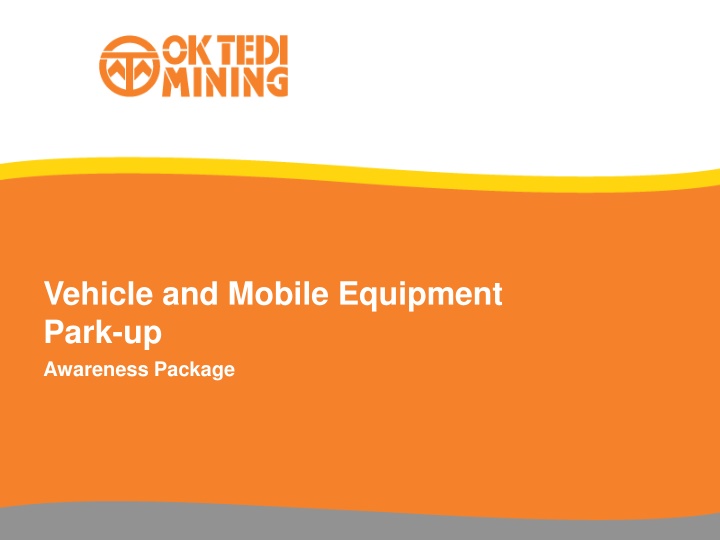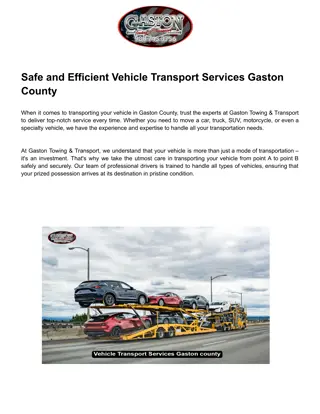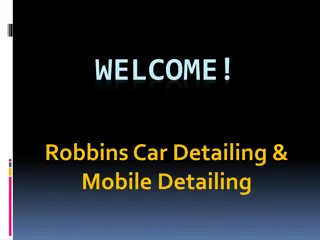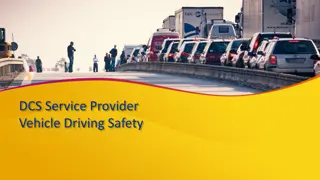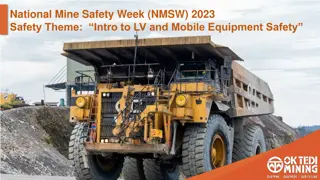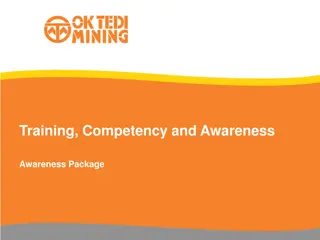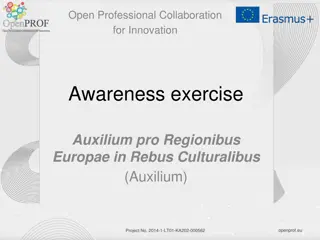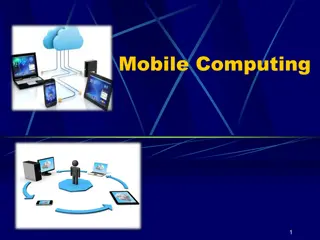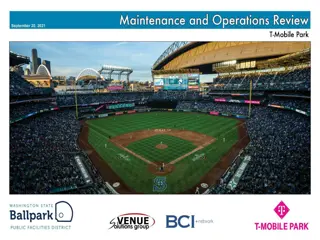Vehicle and Mobile Equipment Park-up Safety Awareness
Protecting people and equipment through proper park-up practices is crucial to prevent accidents. This package emphasizes the hazards, risks, and general principles for safe park-up procedures, ensuring fundamentally stable conditions before leaving vehicles. It also covers pedestrian and passenger safety considerations, highlighting the importance of being aware of surroundings and adhering to signage regulations for safe parking.
Download Presentation

Please find below an Image/Link to download the presentation.
The content on the website is provided AS IS for your information and personal use only. It may not be sold, licensed, or shared on other websites without obtaining consent from the author.If you encounter any issues during the download, it is possible that the publisher has removed the file from their server.
You are allowed to download the files provided on this website for personal or commercial use, subject to the condition that they are used lawfully. All files are the property of their respective owners.
The content on the website is provided AS IS for your information and personal use only. It may not be sold, licensed, or shared on other websites without obtaining consent from the author.
E N D
Presentation Transcript
Vehicle and Mobile Equipment Park-up Awareness Package
Protecting People and Equipment Incorrect park-up is a major cause of vehicle incidents. Park-up is the act of bringing a vehicle or mobile equipment item to a stop, shutting down all systems as per the manufacturer s recommendations and ensuring that the vehicle is FUNDAMENTALLY STABLE and will not move unexpectedly.
General Principles for Park-up Follow manufacturer s recommendations Park light vehicles and heavy equipment separately Park in a V-drain, over a hump or turn front wheels into the kerb, rill or embankment or chock the wheels Park on level ground Park away from traffic flow and be visible to other road users Park so you can drive forward when leaving the parking space Lower implements to the ground NOTE: Never leave a running vehicle unattended
Fundamentally Stable Means that the vehicle / mobile equipment will not move when the transmission is neutralised and the park brake is off Once the vehicle / mobile equipment is fundamentally stable shift the transmission into gear and apply park brake NOTE: All parked-up vehicles must be fundamentally stable before the operator leaves the vehicle
Pedestrian and Passenger Safety Look out for, and give way to, pedestrians When stopping to allow passengers to disembark or to unload cargo, consider: Other traffic in the area Ground conditions Other in the area Park-up and shut down vehicle before passengers disembark Driver / operator must stay in vehicle when passengers on board Pedestrians must stand well clear of equipment and maintain visual contact with drivers / operators
Signage Parking bays Areas delineated as go- lines and dead-lines General parking areas Pedestrian movement / crossings Overhead services (including clearance distances) NOTE: Obey all signage
Warning Signals Be aware of equipment around you Listen for audible warnings such as horn or reversing signals Horn signals: One blast before starting the engine Two blasts before moving forward Three blasts before reversing Wait 5-10 seconds after signalling to enable personnel to move to a safe location before moving the machine
Dismounting from Parked Equipment Dismount only where ladders, nonslip steps and hand holds are provided Do not use controls as hand holds Make sure that steps and handholds are secure and clean Face towards the machine when dismounting Maintain three point contact with steps and handrails NEVER dismount when a machine is moving NEVER jump off a vehicle Keep your body and clothing clear of all pinch points Check ground before stepping off
Surface Car Parks Use designated park-up areas Reverse park Go-lines, dead-lines and other dedicated park-up areas ensure operator safety
Underground Park-up Park 20 metres away from an intersection or significant change of grade Angle vehicle towards the wall with the downgrade wheels on full lock towards the wall to prevent runaway Have the bullbar (front of machine) or bumper (rear of machine) within 1 metre of the wall Apply the hand brake / park brake Put transmission into correct gear Turn the engine off Leave keys in ignition Keep rotating beacon on NOTE: Never walk between any vehicle and the mine wall
Operational Area Park-up Do not park within 50 metres of operating machines unless in a designated parking area Make positive contact with the operator of operating equipment before parking in an operational area Park on safe and level ground with front wheels turned into a berm Chock wheels to prevent uncontrolled movement Lower attachments/implements to the ground
Operational Area Park-up (Cont.) Apply brake Shift transmission into correct gear Turn off the engine Leave rotating beacon on DO NOT park or stand a vehicle: - Where it will create a hazard for other traffic - Behind other parked or standing vehicles where the vehicle cannot be clearly observed - Under or near high walls - On a haul road unless in an emergency - Near a corner - Opposite another vehicle on a haul road (park on the same side of the road)
Park-up for Refuelling Coordinate with other personnel in the area Only refuel at a designated fuel bay Approach the refuelling area at low speed Follow safe driving practices when manoeuvring to the fuel bay When in position, put transmission into correct gear and apply brake Shut down the vehicle Dismount and leave the vehicle cabin, but stay with the vehicle while it is being refuelled Passengers must not remain in the vehicle while it is being refuelled
Emergency Park-up Understand, memorise and use the correct emergency procedures Do not place yourself in unnecessary danger Do not inflict further injuries when moving an already injured person Contact your supervisor Place hazard signs to warn others
Equipment Runaways If you lose control of a vehicle while driving: Apply the service brakes Apply the emergency brakes Change down gears to reduce speed, if possible Lower attachments to the ground to act as a brake Ease the vehicle into a wall or safety barricade Do not engage the transmission in the opposite direction to the vehicle s movement as the engine could stall resulting in no engine braking or service brakes and loss of steering control through the hydraulic system. DO NOT attempt to jump from, or leave, a moving vehicle NEVER attempt to board a runaway vehicle as the risk of being run over is extreme
Summary Safety is Everyones Responsibility Follow OTML guidelines and procedures Obey signage instructions Park vehicles and mobile equipment in designated parking areas Make sure vehicle is fundamentally stable Shut down engine before exiting a parked vehicle Ensure path is clear of obstructions and personnel before moving from a parked position Use appropriate communication warning signals
